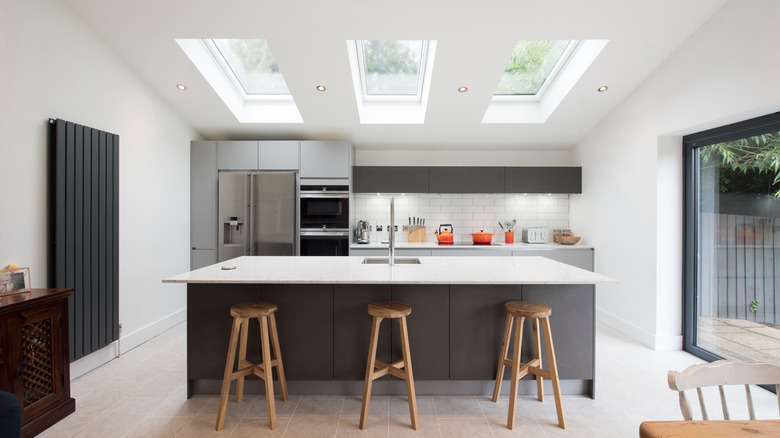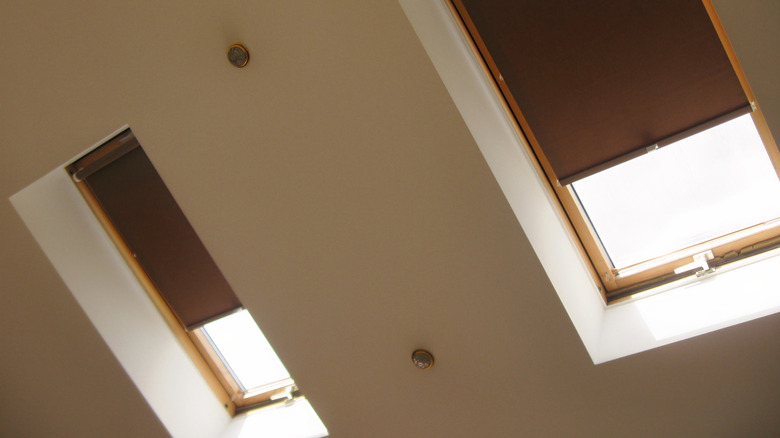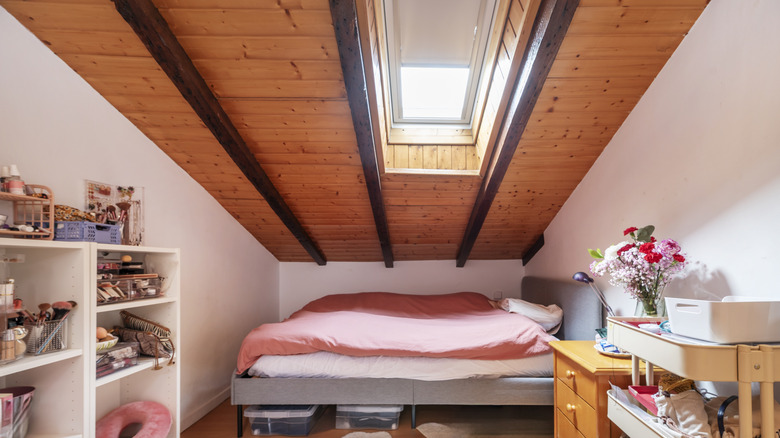The Mistake To Avoid When Adding Skylights To A Home
We may receive a commission on purchases made from links.
From gorgeous natural light streaming down to increased ventilation that improves your home's air quality, skylights can benefit your living space in many ways. What you might not consider is that having all that natural light — and the thermal energy that comes with it — isn't always desirable. Skylights can cause too much heat in the summer, increased cold in the winter, fading on your furniture, and a glare where you don't want it. If you're not considering window treatments as you plan your skylight installation, you could be making a big mistake that affects your home's comfort.
Adding a skylight comes with many decisions, including the size, shape, and location of the roof light, all of which impact your comfort and your home's energy efficiency. The direction the skylight faces is one example. East- versus west-facing skylights impact whether you get direct sunlight in the morning or afternoon. Sometimes, those decisions come with compromises. To benefit from the increased heat gain in the winter, you have to deal with the blazing heat in the summer with a south-facing skylight, for example.
Window treatments help you deal with the less appealing parts of having a skylight, no matter how it's positioned. You have a variety of options, including built-in and motorized blinds that give you convenient control even if the skylight is out of reach. Adding one of the covering options lets you control natural light, increase or decrease heat gain, and minimize fading caused by UV rays.
Why you shouldn't skip window coverings
Skylight blinds give you more control over the natural light coming through the glass. When the light comes in at a certain angle, it often makes viewing screens difficult due to glare or excess light. With window coverings, you can close the blinds partially or fully to minimize glare on TV and computer screens. You can also shut out the direct UV rays when they hit your cherished sofa or other furnishings that are susceptible to fading. On extra bright days, you may decide to block some or all of the light to soften it.
Window coverings also help you improve the skylight's energy efficiency by controlling heat gain and loss. In the summer, the sunlight from the skylight can heat up the room, causing your air conditioner to work harder. The uncomfortable heat gain is often worse with south-facing skylights. Closing the blinds in the summer keeps your room cooler.
In the winter, the direct sunlight from a south-facing skylight could help heat up your home in the winter. However, you can also lose heat through the glass, especially since warmer air rises to the ceiling where skylights are located. Closing the skylight shades in the winter, especially after the sun sets–like you do with regular windows–is one of many ways to insulate your home against the cold. The window treatment helps trap heat indoors to help your furnace work more efficiently.
Available window treatment options for skylights
Identifying the specific issues you want to correct will help you choose the ideal window treatment type for your skylight. The goal of a skylight is often to harness natural sunlight to brighten up a dark room, so you might not want to block the sun completely. Light-filtering window treatments with sheer fabrics ease the glare you can sometimes get from skylights and soften harsh rays, offering filtered light that still brightens your room. This option may work well in common areas like your kitchen or living room, where bright light is a bonus. If you have a skylight in your bedroom, though, you might prefer room-darkening or blackout skylight shades to block out more of the light on mornings when you want to sleep in.
If energy efficiency is the primary focus, honeycomb or cellular shades designed for skylights, such as the ZSHINE Cordless Full Blackout Cellular Shades, offer an insulating quality. The air inside the cells blocks heat and cold from transferring through the shades. Cellular shades made for skylights typically use side rails to hold the window treatments in place. You can also choose shades designed to block UV rays if you want to minimize fading and sun damage to your interior.
The other issue to consider is how to control the shades on skylights that are out of reach. Manually operated shades often include cranks or poles to open and close the shades. If you want to spend a little more for increased convenience, consider motorized shades that operate using remotes or phone apps.


